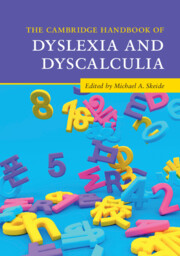Book contents
- The Cambridge Handbook of Dyslexia and Dyscalculia
- The Cambridge Handbook of Dyslexia and Dyscalculia
- Copyright page
- Contents
- Figures and Tables
- Contributors
- Acknowledgements
- General Introduction
- Part I Theoretical Frameworks and Computational Models
- Part II Cognitive Profiles and Behavioural Manifestations
- Part III Genetic and Environmental Influences
- Part IV Neurodevelopmental Foundations
- Part V Gender, Ethnicity, and Socioeconomic Background
- 13 Gender and Sex Differences in Dyslexia and Dyscalculia
- 14 The Role of Socioeconomic and Ethnic Disparities for Dyslexia and Dyscalculia
- Summary: Gender, Ethnicity, and Socioeconomic Background
- Part VI Cultural Unity and Diversity
- Part VII Early Prediction
- Part VIII Intervention and Compensation
- Part IX Best Practice – Diagnostics and Prevention
- Part X Best Practice – Schooling and Educational Policy
- General Summary
- References
- Index
- References
13 - Gender and Sex Differences in Dyslexia and Dyscalculia
from Part V - Gender, Ethnicity, and Socioeconomic Background
Published online by Cambridge University Press: 28 July 2022
- The Cambridge Handbook of Dyslexia and Dyscalculia
- The Cambridge Handbook of Dyslexia and Dyscalculia
- Copyright page
- Contents
- Figures and Tables
- Contributors
- Acknowledgements
- General Introduction
- Part I Theoretical Frameworks and Computational Models
- Part II Cognitive Profiles and Behavioural Manifestations
- Part III Genetic and Environmental Influences
- Part IV Neurodevelopmental Foundations
- Part V Gender, Ethnicity, and Socioeconomic Background
- 13 Gender and Sex Differences in Dyslexia and Dyscalculia
- 14 The Role of Socioeconomic and Ethnic Disparities for Dyslexia and Dyscalculia
- Summary: Gender, Ethnicity, and Socioeconomic Background
- Part VI Cultural Unity and Diversity
- Part VII Early Prediction
- Part VIII Intervention and Compensation
- Part IX Best Practice – Diagnostics and Prevention
- Part X Best Practice – Schooling and Educational Policy
- General Summary
- References
- Index
- References
Summary
There are intrinsic similarities between boys and girls in the cognitive and neural mechanisms characterizing typical reading and mathematics development, with few and small behavioural differences emerging between genders in older age groups. The similarities between the cognitive and neural processes of boys and girls in these domains are sometimes surprising because folk beliefs about differences between males and females pervade scientific discourse in psychology and even impact empirical research (Hyde and Linn 1988) and clinical practices (Shaywitz et al. 1990). The universal patterns of cognitive and neural development across gender groups are important to appreciate, not only because they are potentially surprising empirical facts, but also because they expose candidate sources of disorder in reading and mathematics. Research on typically developing children can reveal the specialized cognitive and neural mechanisms at the core of reading-specific and mathematics-specific deficits in boys and girls.
- Type
- Chapter
- Information
- The Cambridge Handbook of Dyslexia and Dyscalculia , pp. 233 - 250Publisher: Cambridge University PressPrint publication year: 2022

